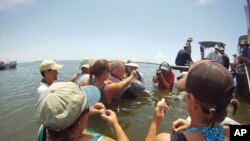Scientists Find Sick Dolphins and Deep-Water Corals in Gulf of Mexico Oil Spill Zone
Two groups of scientists say they have identified signs of poor health in dolphins and in deep-sea corals due to exposure to polluted water in the northern Gulf of Mexico where the Deepwater Horizon oil spill occurred nearly two years ago.
The deadly April 2010 disaster is the worst off-shore oil spill in U.S. history.
A team of biologists assessing the health of a resident pod of dolphins in the Gulf’s Barataria Bay say their preliminary findings indicate the marine mammals are suffering from low body weight, anemia, low blood sugar, and symptoms of liver and lung disease. Also, nearly half of the 32 dolphins they tested in mid-2011 have abnormally low levels of certain hormones that help with stress response, metabolism and immune function.
One of the dolphins they examined was found dead in January, and the researchers fear more will die.
The scientists say the dolphins’ ailments are similar to those found in other mammals exposed to oil, but their current findings do not specifically link the animals’ illness to the Deepwater Horizon oil spill.
The dolphin study is part of the U.S. National Oceanic and Atmospheric Administration’s (NOAA) Natural Resource Damage Assessment, which is a continuing analysis of how the Deepwater Horizon oil spill has impacted plant and animal life in the Gulf of Mexico.
Meanwhile, researchers who conducted a separate study say their observations and a detailed chemical analysis have yielded strong evidence of the impact of the Deepwater Horizon oil spill on deep-sea corals 1,300 meters below the surface of the Gulf of Mexico.
The Penn State University-led study co-authors say they found communities of corals 11 kilometers from the source of the oil spill that were covered in a fluffy, brown, mucus-like substance, and showing signs of tissue damage and severe stress. They note that coral colonies they examined at sites located at least 20 kilometers from the ruptured seafloor oil well were clean and thriving.
The study of the deep-water corals is published in the journal, Proceedings of the National Academy of Sciences.
NOAA released the dolphin study preliminary results last Friday.
The Deepwater Horizon oil spill occurred April 20, 2010 when a damaged British Petroleum well on the seabed 80 kilometers off the coast of the southern U.S. state of Louisiana released nearly five million barrels of crude oil into Gulf waters before it was capped nearly 90 days later. Eleven oil workers were killed in the explosion that damaged and sank the BP-leased oil rig.
Some information for this report was provided by AP and AFP.
News
Scientists Find Sick Dolphins and Deep-Water Corals in Gulf of Mexico Oil Spill Zone









